Located on the banks of the Mekong, the capital of Laos, Vientiane is the starting point for all excursions in Laos. Here, you can stroll serenely to discover the cultural treasures of this colonial city. Don’t immediately seek to move away from the capital in order to seek the authenticity of the country, it would be a shame not to stay there for a few days because this city also has its own particularities and will know how to charm you.
General Information
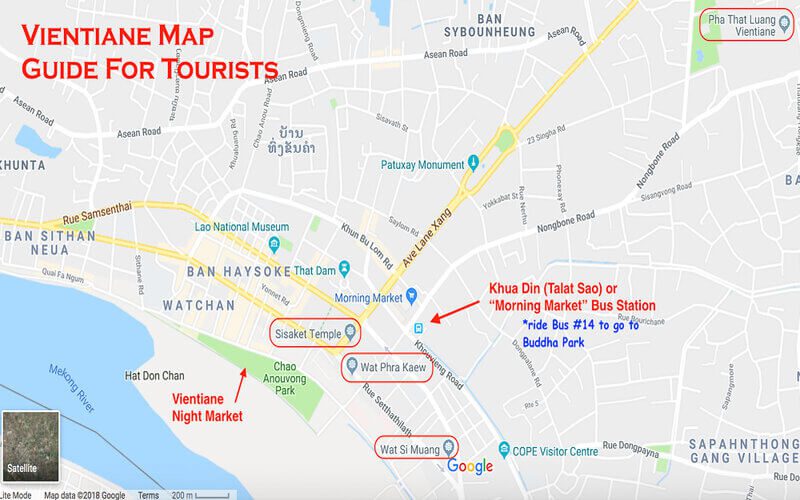
Vientiane Map Guide For Tourists
How to Get to Vientiane
By Plane
Vientiane Wattay International Airport (VTE) is located about 6 km to the West of the city center. The airport is only served by a small group of airlines, including China Eastern, EVA, Lao Aviation, Thai Airways, and Vietnam Airlines.
International destinations from there are Bangkok, Chiang Mai via Luang Prabang, Hanoi, Ho Chi Minh City, Vinh, Kuala Lumpur, Phnom Penh, Siem Reap via Pakse, Seoul, Singapore, Changzhou, Guangzhou, Nanning, and Kunming.
(*)From Bangkok, many travelers choose to fly to Udon Thani in Thailand and then cross the border by bus because this domestic flight is cheaper than a straight flight from Bangkok to Vientiane.
Domestic destinations are Luang Prabang, Luong Nam Tha, Huay Xai, Xieng Khuang, Udomxai, Pakse, and Savannakhet.
By Train
Getting to Vientiane from Bangkok by train is very simple, you can take the daily overnight train from Bangkok to Thanaleng Station in Laos, then take a tuk-tuk or a bus to Vientiane. You can also take the Bangkok – Nong Khai train and then travel by bus or taxi between Nong Khai and Vientiane. The journey takes around 13 hours. The ticket price depends on the cabin and the seat you choose, the hard or soft seat, air-conditioned cabin or not.
By Bus
International buses:
- Bangkok – Vientiane: 12 hours
- Kunming – Vientiane: 32 hours
- Vinh – Vientiane: 4 hours
- Hanoi – Vientiane: 22 hours
- Phnom Penh – Vientiane: 24 hours
- Siem Reap – Vientiane: 25 hours
Domestic buses
You can buy tickets from a guest house in Vientiane or contact us to book in advance. You will be picked up from your accommodation and transferred to the bus station or departure point.
- From Luang Prabang or Xieng Khuang, the trip usually takes 10 hours and costs 110,000 – 150,000 Kips.
- From Pakse takes about 10 to 12 hours and costs 110,000 – 170,000 Kips.
- From Savannakhet, the journey takes 8 to 10 hours and costs 110,000 – 120,000 Kips.
- From Huay Xai, it takes more than 12 hours and costs 230,000 – 250,000 Kips.
Getting around Vientiane
Tuk-tuk
It is a very convenient way to visit the city. The price may be quite high, so you will always need to negotiate! The fair price for a ride in the city is 20,000 or 50,000 Kips for 10 km.
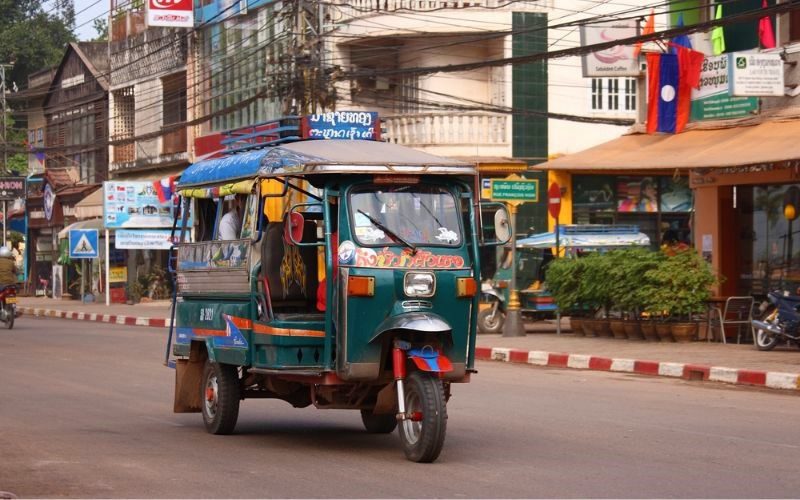
Tuk-tuk
Bike
Cycling around the city is also a great option. You can find car rentals in hotels or in the streets of the central market to discover the tourist sites of Vientiane like the Patuxay or Pha That Luang.
Bus
It is one of the most popular transports in Vientiane. The cost is only about 50,000 Kips/person. Laos buses are quite modern, and the driver and assistant are very friendly.
Vientiane has green and white air-conditioned buses that serve routes throughout the city. They leave from the central bus station and you can wave them anywhere on the route and hop on. To pay the driver or attendant, the cost ranges from 2,000 to 6,000 Kips. The most important routes for travelers are Bus No. 14, which goes on Thadeua Rd to Friendship Bridge and Buddha Park, and Bus No.19 to the Southern Bus Station.
Private car
IDC Travel offers a car rental service in Vientiane at a very reasonable price. Our car can open the chance to some independent adventures off the beaten track. Please contact us for more information.
Weather and Best Time to Visit Vientiane
Vientiane has a tropical climate, it is divided into the dry season and the wet season.
The temperature ranges from hot to very hot, with some very humid days when the rains mark the start of the Southwest monsoon in May or June. The rainy conditions continue till the end of October, then the Northeast monsoon arrives, bringing dry and cooler days. From November to February, Vientiane experiences the most comfortable and sunny days, the temperature rises in March, April, and May.
The best time to visit Vientiane is from November to March. But these months are when the city welcomes a large crowd of tourists. Flights and hotel prices are very high at this time of the year, but you can enjoy cooler weather.
If you come to Vientiane in April, you will have hot and sticky days, but it can also be an opportunity to see how the locals cool off with their New Year’s water festival. Similar to the famous Songkran festival in Thailand, the scale and the popularity of the Vientiane version are much smaller, but just as pleasant (and less over-enthusiastic tourists).
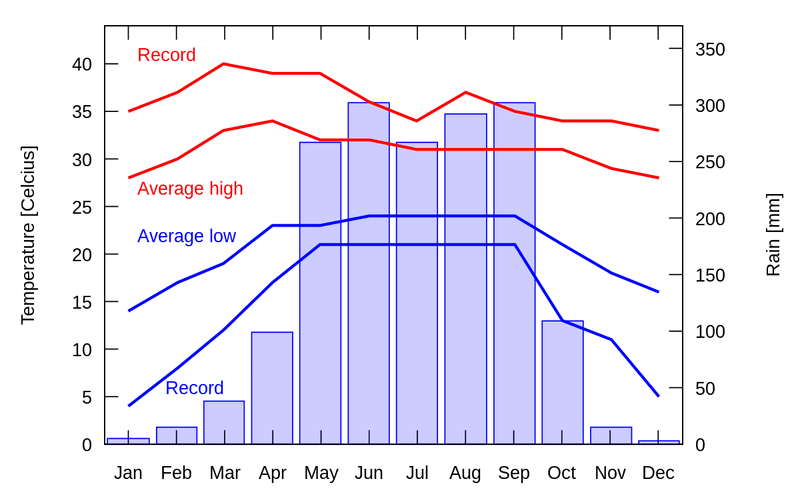
Vientiane Weather
>>> Read more: Laos Weather: When is the Best Time to Visit Laos?
Accommodations in Vientiane
Like many cities in Asia, finding a stay in Vientiane won’t be a problem, the accommodation offered is sufficiently wide and inexpensive throughout the city.
Downtown Vientiane
Downtown Vientiane is made up of a grid of one-way streets bordered by the Mekong River and Quai Fa Ngum to the South, Samsenthai Road to the North, Chou Anou Road to the West, and the Presidential Palace to the Southeast. Everything is easily accessible on foot from the Mekong and the night market. Here are some hotels for your reference:
- Salana Boutique Hotel
- Laos Orchid Hotel
- Dhavara Hotel
- City Inn Vientiane
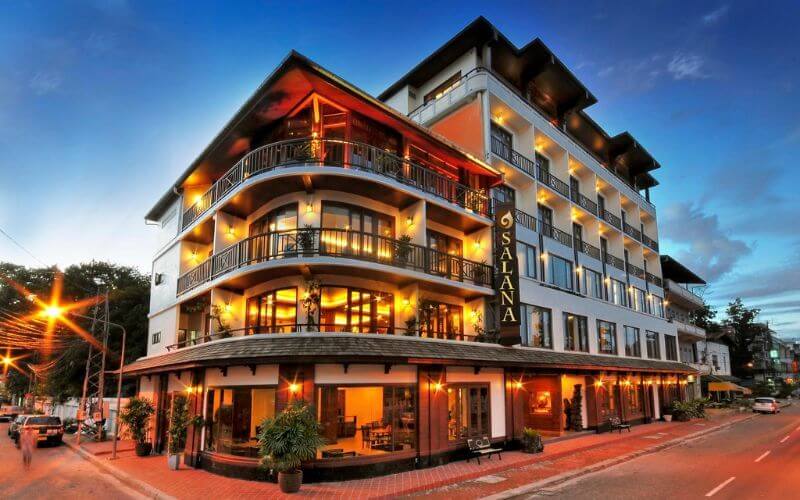
Salana Boutique Hotel – Vientiane
Outside the city center
You will find all the guest houses and hotels are a little further from the city center. All the accommodations listed below are located within 2 miles of the city center:
- Mandala Boutique Hotel
- Settha Palace Hotel
- Village Lao Traditional Hotel
- Villa Manoly
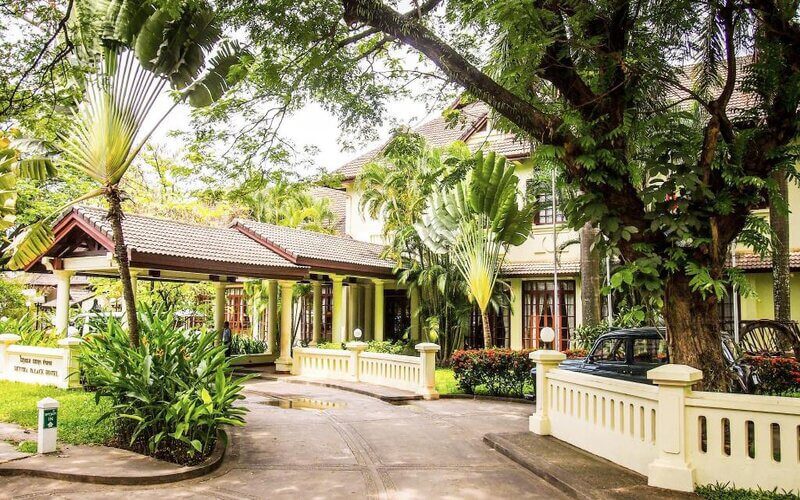
Settha Palace Hotel
Places To Visit in Vientiane
Pha That Luang
Can be seen from afar, this golden monument is the most sacred place and is one of the symbols of Laos. The Laos word for “highest stupa” is said to contain the hair of the Buddha. It was built in 1566 after King Setthathirath made Vientiane the new capital of the Lan Xang Kingdom. The That Luang festival is held every year on the first full moon of November and lasts for a week, attracting thousands of devotees and monks to the capital to participate in religious ceremonies. Not just only the Buddhist rituals, there are also games, dances, and traditional songs. Not to be missed if you visit the capital of Laos during this period.
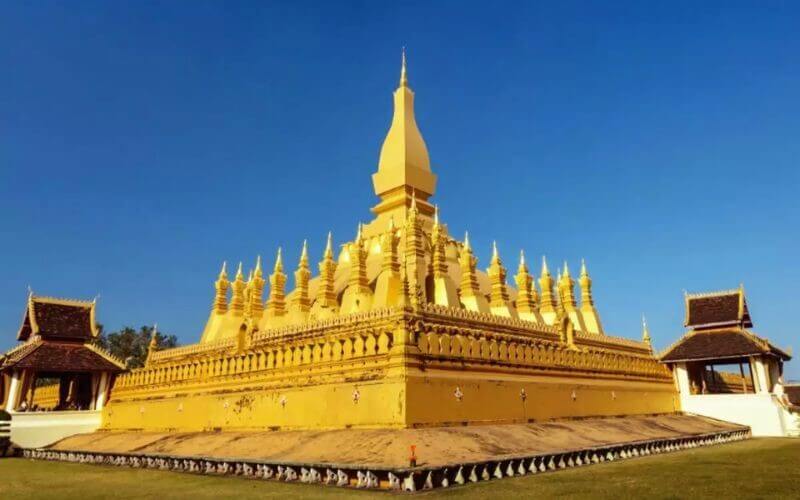
Pha That Luang – Vientiane
Patuxay Monument
Patuxay Monument means “the door of victory”, it was built in 1962, in memory of the dead in the war for independence between Laos and France. This beautiful monument is located in the center of the city, and it is surrounded by pretty gardens, very popular and familiar to the locals, who come to walk there in the evening in the cool. In addition, from the terrace and from the top of the central tower (197 steps) you can enjoy a beautiful view of the city, especially on Lan Xang Avenue which leads to the Presidential Palace and the Mekong River.
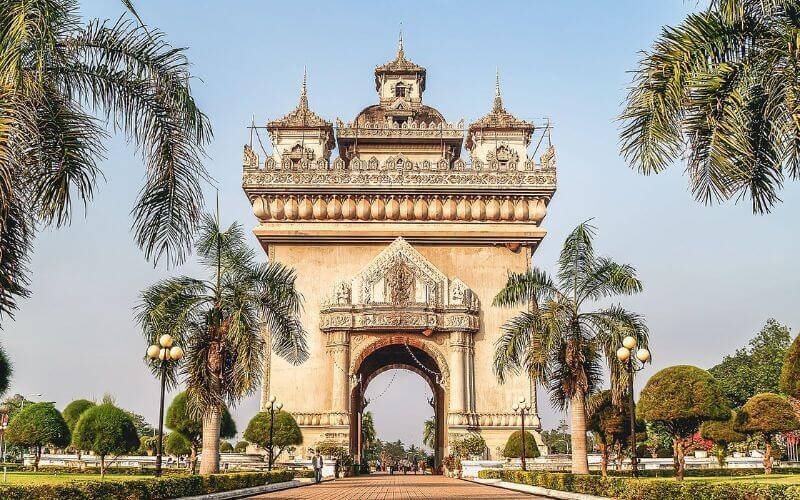
Patuxay Monument – Vientiane
Wat Simuang
This elegant and famous temple marked the Southeast entrance to the city in the 16th century. According to a legend, a pregnant woman sacrificed herself by throwing herself into the hole made to build the city pillar and became the guardian of the city. Every day, this Buddhist temple attracts crowds of local Buddhists who want to pray for its “good luck” powers. They say that if you pray in this place, making a wish while at the same time making a promise, your wish will be granted, provided you return and fulfill your promise.
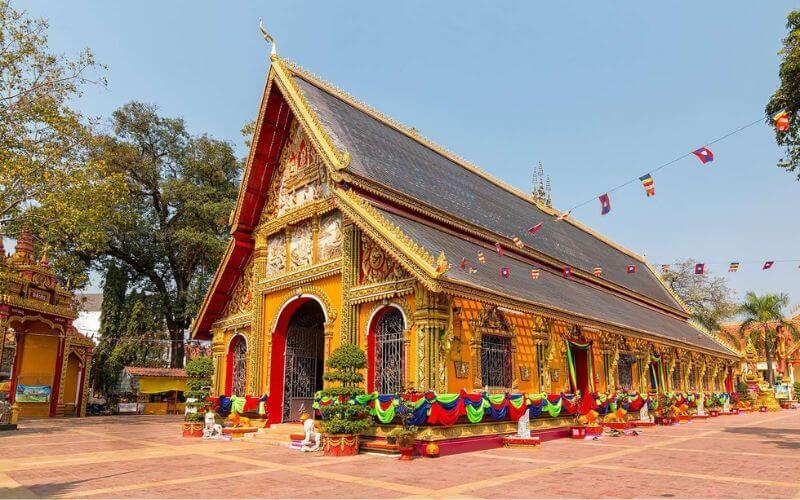
Wat Simuang – Vientiane
Wat Si Saket
It is the oldest temple of Vientiane, built-in 1818 by the order of King Anuvong and completed in 1824. Wat Si Saket is the only temple that survived the Siamese Invasion for its Thai style. This temple is also known for its Buddha statues here are mainly wooden carvings, located in the courtyard gallery.
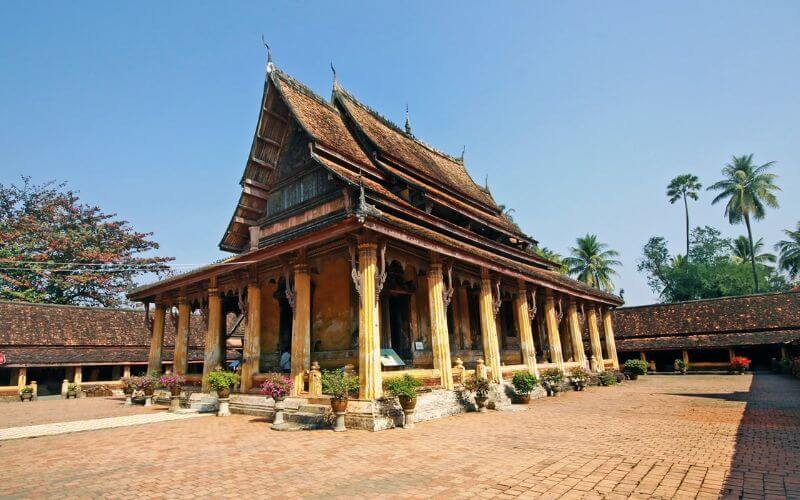
Wat Si Saket – Vientiane
Laos National Museum
Occupying the former French Governor’s residence built in the 1920s, the National Museum is essentially devoted to the evolution of the country. From prehistory to national independence, the museum allows you to discover the country’s history through a series of themed exhibitions. The ethnic groups of Laos are presented there as well as some remarkable pieces, including a jar from Phonsavan, megalithic steles, bronze drums from the Dong Son civilization, and also various objects from the daily life of the Laotians.
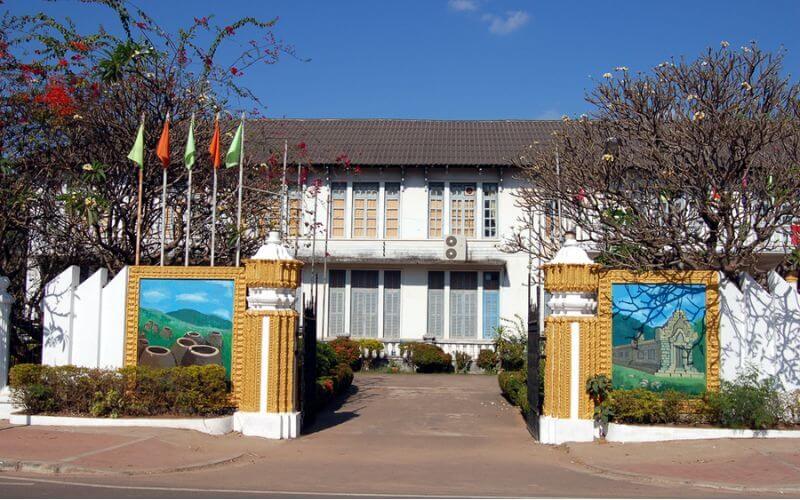
Laos National Museum – Vientiane
Buddha Park
The park is located 25 km outside of Vientiane with about 200 concrete Buddhist and Hindu statues: Hindu deities, mythological animals, demons, or classic scenes from the Buddhist saga. This park was initiated in 1958 by an eccentric yogi priest shaman who wanted to merge Buddhist and Hindu philosophies, mythologies, and iconography. The park is the place where you can admire sculptures of the deities of the two religions, Shiva, and Vishnu, or even a reclining Buddha twenty meters long, which is the subject of deep popular veneration.
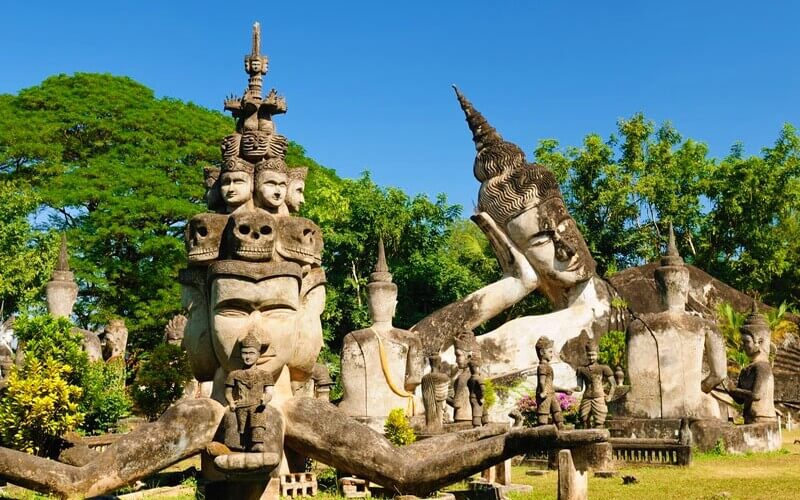
Buddha Park – Vientiane
COPE Visitor Center
COPE is a local cooperative founded in 1997, exhibiting devices and prosthetics to UXO victims and attempting to raise awareness of the drama of unexploded ordnance during the CIA’s covert warfare during the Vietnam War. Laos holds the sad record of being the most bombed country in history. During the war, more than 2 million tons of bombs were dropped. An interesting and very moving sites to visit.
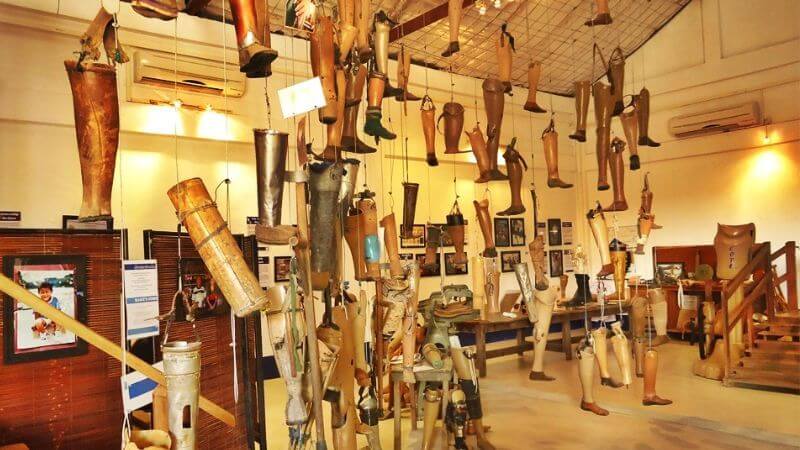
COPE Visitor Center – Vientiane
Phou Khao Khouay National Park
This protected area conceals many natural wonders, including an ecosystem conducive to an incredible diversity of endangered animal species such as panthers, gibbons, peacocks, and wild elephants. The biodiversity in terms of plants and insects is also remarkable! A magnificent hike allows you to discover all these riches and bathe in superb waterfalls.
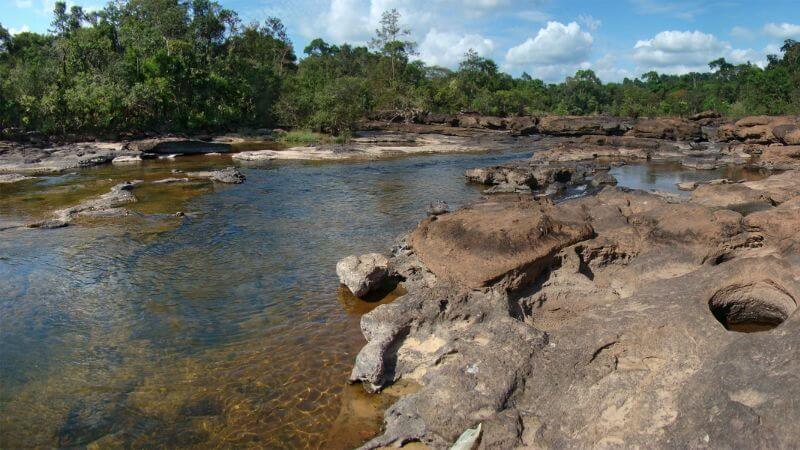
Phou Khao Khouay National Park – Vientiane
Talat Sao
Called the “morning market”, it is actually open from the early morning until 4 pm. Dating back to the 1960s, you will find a wide variety of shops there, and goods are sold at reasonable prices. Fabrics, clothing, jewelry, electric equipment, souvenirs, and many more.
Must-Eat Foods in Vientiane
Don’t miss the chance to taste the local flavors on a sidewalk in Vientiane. It’s difficult to resist the smell of grilled meat or fish, there is always something for everyone.
Tam Mak Houng (Papaya Salad)
It is one of the first choices of many tourists when they come here because this dish is sold on every street corner, very cheap and delicious! Tam Mak Houng means papaya salad in the Lao language. The papayas are chopped and stabbed lightly in a small mortar. When you taste this dish, you can feel the spiciness, the acidity of the condiments, and the taste of papaya.
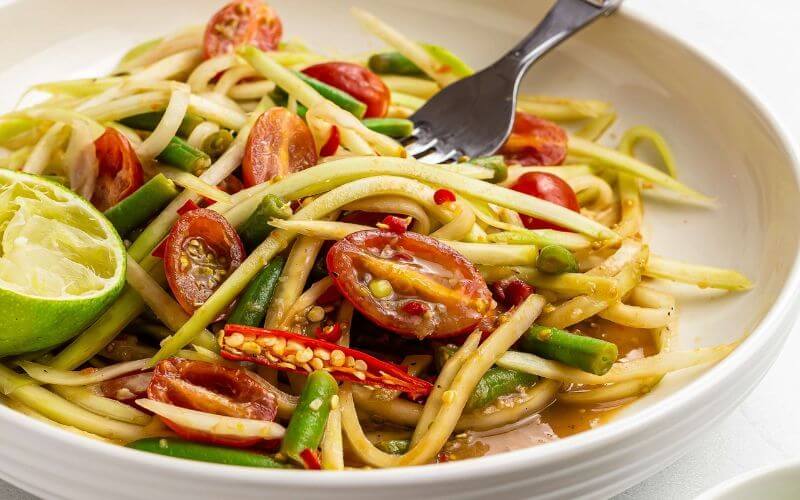
Tam Mak Houng
Larb
This is a traditional Laos dish that often appears during major holidays, especially in New Year. A variety of minced meat (pork, beef, chicken or deer) is used with aromatic herbs, mint leaves, lemon juice, and chili. Rice is usually added while the mixture is quickly stirred in a saucepan. Larb is the dish to try when you visit this country.
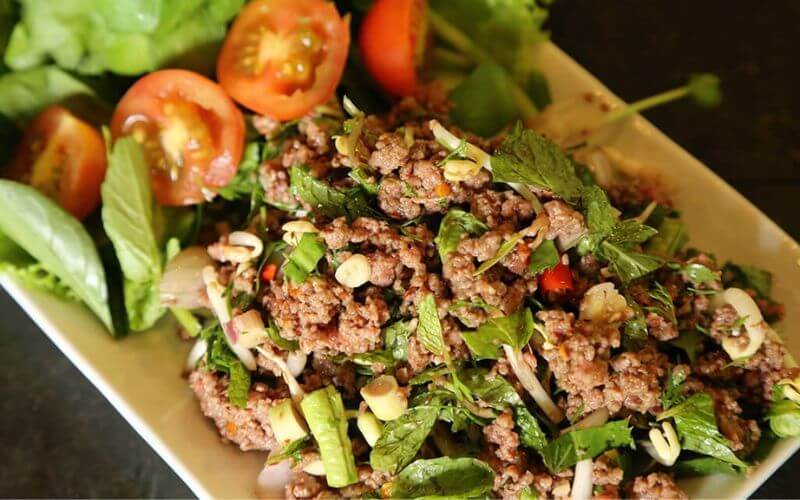
Larb
Sticky rice
Sticky rice in Vientiane is fragrant and tasty, especially fluffy, and won’t stick to your hands. Locals have them with chicken, boiled vegetables, and “jaew boong”, a classic Lao sauce. With only 15,000 to 30,000 Kips, you can eat sticky rice wrapped in a bamboo basket with an attractive aroma.
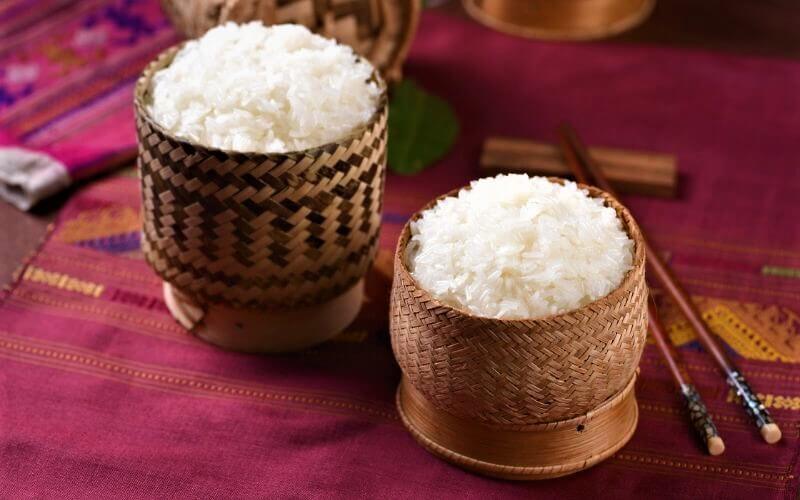
Sticky Rice
Grilled fish
Grilled fish is a specialty not to miss in Vientiane. The fish are caught directly from the Mekong River so they are very fresh and delicious. This dish is simply prepared and considered the best fish delicacy in the country. The fish are marinated with salt for 15 minutes to absorb all the saltiness, then grilled directly over charcoal. This dish is often served with aromatic herbs and a special sauce consisting of pork liver, chili powder, onion, lemon juice, and a little sesame. Laotians often eat grilled fish with sticky rice and chili salt.
Khao Piak Sen
You can easily find this dish in the markets or on a crowded street in the morning as the locals often have it at this time of the day. However, don’t worry, there are small restaurants open all day to serve you. To know which restaurant is good, choose the one that is the most frequented.
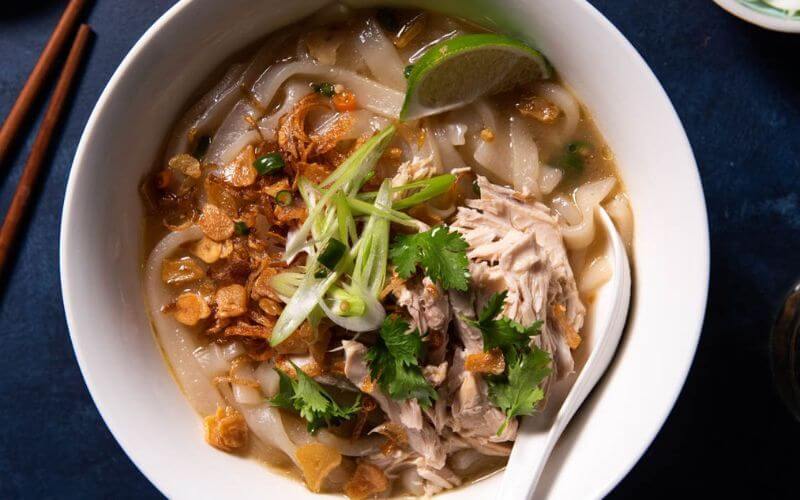
Khao Piak Sen
An essential stopover during your trip to Laos is Vientiane – the capital of the country. The city offers multiple activities that will make your trip more interesting. Contact us right now if you are ready for your first stay in Vientiane. Don’t forget to read our Laos Travel Guide before packing your luggage for a general view of tourism in Laos.